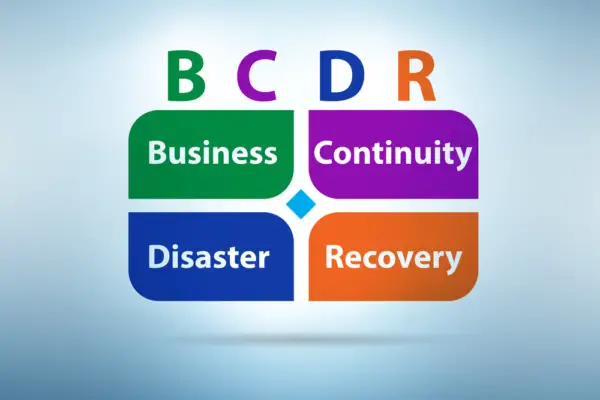A Business Continuity Plan (BCP) is a strategic framework that prepares businesses to maintain or swiftly resume their critical functions in the face of a disruption or disaster, such as fire, flood, or cyberattack.
It outlines procedures and instructions an organization must follow to ensure that personnel and assets are protected and able to function during and after a crisis.
A BCP is an essential part of an organization’s risk management strategy and is designed to prevent interruptions to normal operations and to re-establish full functioning as swiftly and smoothly as possible (Investopedia).
In today’s dynamic and unpredictable business landscape, organizations must be prepared to navigate through unexpected disruptions and crises. This is where a robust business continuity plan (BCP) comes into play.
A BCP is a proactive approach that enables businesses to identify potential risks, protect critical operations, and quickly recover in the event of a disruption.
But what exactly does a business continuity plan entail? How does it help organizations mitigate risks and maintain resilience?

Join me as we explore the intricacies of BCP, from its definition and importance to the steps involved in its implementation. Get ready to discover the key elements that ensure operational continuity and safeguard the future of businesses.
Key Takeaways
- A business continuity plan (BCP) is a strategic document that outlines procedures and protocols for critical operations during and after a disruptive event.
- BCP helps organizations identify risks, develop mitigation strategies, and establish protocols for crisis situations.
- BCP enables timely and accurate communication with employees, stakeholders, and customers, considering customer impact and strategies to maintain satisfaction and loyalty.
- BCP is essential for organizations to protect revenue and minimize the impact of disruptions, demonstrating organizational commitment to resilience and preparedness.
Definition of business continuity plan
A business continuity plan, also known as a BCP, is a strategic document that outlines the procedures and protocols an organization will follow to ensure its critical operations can continue during and after a disruptive event or crisis.
This contextually relevant article section aims to define a business continuity plan and its importance in mitigating the impact of business disruptions.
A well-defined BCP provides an organization with a roadmap to navigate through unforeseen challenges, ensuring the safety and well-being of its employees and the continuity of services to customers.
It includes steps for identifying potential risks, establishing recovery strategies, and implementing measures to minimize downtime.
Importance of having a robust business continuity plan
Having a robust business continuity plan is essential for organizations to effectively navigate through disruptions and safeguard their operations.
In today’s dynamic and unpredictable business environment, it is crucial to have a plan in place that can address various potential threats and minimize their impact on the organization.
Here are four reasons why a robust business continuity plan is of utmost importance:
- Protection of critical business functions: A well-developed plan ensures that critical business functions can continue even during a crisis, minimizing downtime and reducing financial losses.
- Business impact analysis: A robust plan includes a thorough analysis of potential risks and their potential impact on the organization, allowing for proactive measures to be taken.
- Effective communication: A continuity plan provides guidelines for efficient communication during a crisis, ensuring that relevant stakeholders are informed and involved in the decision-making process.
- Reputation management: By having a plan in place, organizations can demonstrate their commitment to resilience and preparedness, enhancing their reputation among clients, partners, and the public.
Understanding Business Continuity Planning
Understanding Business Continuity Planning is crucial for organizations to effectively respond to and recover from potential disruptions or disasters.
This subtopic will explore the definition and purpose of Business Continuity Planning, shedding light on its role in maintaining operations and minimizing the impact of unforeseen events.
Definition and Purpose
Business Continuity Planning encompasses the strategic framework and operational measures put in place to ensure the uninterrupted functioning of a business in the face of unexpected disruptions.
It involves a comprehensive business continuity plan that outlines the steps to be taken to mitigate risks and maintain business resilience.
The purpose of business continuity planning is to minimize the impact of disruptions on critical business processes and ensure their swift recovery.
It aims to provide a structured approach to managing risks and developing strategies to maintain business continuity.
Key components of business continuity planning include the development of a business continuity strategy, the implementation of a business continuity planning process, and the establishment of a business continuity management framework.
A business continuity program should be supported by a business continuity plan template, which serves as a guide for organizations to effectively respond to and recover from disruptive events.

Defining business continuity planning (BCP)
A well-crafted business continuity plan is a vital tool for ensuring the resilience and sustainability of organizations in the face of potential disruptions.
Defining business continuity planning (BCP) involves understanding its components and actions.
BCP aims to identify and prioritize essential functions within an organization, ensuring that critical functions can be maintained or quickly recovered in the event of a disruption.
It encompasses the development of recovery strategies and the establishment of recovery time objectives (RTOs) to minimize downtime and mitigate the impact of disruptions on business operations.
By defining BCP, organizations can proactively prepare for potential threats, such as natural disasters, cyberattacks, or pandemics, and implement measures to safeguard their critical functions.
This proactive approach helps organizations maintain operational continuity and minimize financial losses during times of crisis.
The purpose of BCP in organizations
The purpose of a Business Continuity Plan (BCP) in organizations is to ensure the resilience and continuity of business operations in the face of unexpected disruptions or disasters.
It helps organizations identify potential risks, develop strategies to mitigate them, and establish clear protocols and procedures to follow in times of crisis.
Key Components of a Business Continuity Plan
Organizations rely on a comprehensive Business Continuity Plan (BCP) to ensure uninterrupted operations during unexpected disruptions.
A BCP consists of several key components that are critical to maintaining business operations and minimizing the impact on customers and revenue loss.
Contingency Plan: A well-defined contingency plan outlines the steps to be taken in the event of a disruption, such as a power outage. It includes procedures for identifying and assessing risks, as well as implementing measures to mitigate them.
Recovery Plans: Recovery plans focus on restoring business operations to normalcy after a disruption. They include strategies for recovering critical components, such as data, systems, and infrastructure, to minimize downtime and maximize efficiency.
Communication Plans: Effective communication is essential during a disruption. Communication plans outline the channels and protocols for internal and external communication, ensuring timely and accurate information is shared with employees, stakeholders, and customers.
Impact on Customers: A BCP considers the impact on customers and prioritizes their needs. It includes strategies for maintaining customer satisfaction and loyalty during a disruption, such as alternative service delivery channels or temporary solutions.
Identifying critical business functions
Identifying the critical functions within a business is essential for developing a robust and effective Business Continuity Plan.
A business continuity plan aims to ensure that a company can continue its normal business operations in the event of a disruption or disaster.
By identifying the critical business functions, organizations can prioritize their resources and efforts towards protecting and recovering these key areas.
To identify critical business functions, companies must consider factors such as revenue generation, customer impact, and legal and regulatory requirements.
They should also assess the potential impact of various scenarios, including natural disasters, cyber-attacks, or human error. This assessment helps in developing appropriate contingencies and recovery systems.
The process of identifying critical business functions typically involves input from various stakeholders, including the business continuity team, department heads, and emergency responders.
By understanding and prioritizing these functions, companies can develop strategies and resources to ensure their continuity and minimize the impact of disruptions on their overall operations.
Conducting a business impact analysis (BIA)

Conducting a business impact analysis (BIA) is a crucial step in developing a comprehensive business continuity plan.
It helps organizations identify and prioritize critical business functions and assess the potential impact of a disruption or incident.
Here are four key aspects of conducting a BIA:
- Identify critical business functions: Determine which functions are essential for the survival and continued operation of the business, considering both internal and external dependencies.
- Assess potential risks: Evaluate the likelihood and potential impact of various risks such as natural disasters, emergencies, or technology failures that could disrupt business operations.
- Analyze potential impacts: Understand the consequences of a disruption, including financial losses, reputational damage, and regulatory compliance issues.
- Prioritize business continuity activities: Based on the BIA findings, develop strategies and plans to mitigate risks, minimize downtime, and ensure timely recovery in the event of a potential incident or outage.
Developing recovery strategies for essential functions
Developing recovery strategies for essential functions is a critical aspect of ensuring business continuity in the face of potential disruptions or incidents.
A business continuity plan should outline the steps necessary to recover essential functions in a timely manner, minimizing the impact of a disruptive event.
Recovery strategies should address various scenarios such as infrastructure failure, loss of revenue, or other potential losses.
To develop effective recovery strategies, organizations need to establish recovery point objectives (RPOs), which determine the acceptable amount of data loss in the event of a disruption.
This helps prioritize essential functions and develop strategies for rapid recovery. It is also important to identify backup site providers that can support critical operations during an incident.
Steps in the Business Continuity Planning Process
When developing a business continuity plan, there are several key steps that need to be taken.
The first step is conducting a risk assessment and analysis to identify potential threats and vulnerabilities.
This is followed by a business impact analysis (BIA) to determine the potential consequences of a disruption.
Once these assessments are complete, the next step is to develop and select appropriate strategies to mitigate the identified risks.
1. Risk Assessment and Analysis
A comprehensive and thorough risk assessment and analysis is a crucial step in the business continuity planning process.
It helps organizations identify and evaluate potential risks and vulnerabilities that could impact their operations.
By conducting a risk assessment, businesses can better understand the likelihood and potential impact of an unexpected event or disaster event, enabling them to develop appropriate strategies for emergency management and emergency response.
Key objectives of risk assessment and analysis include:
- Identifying potential risks and vulnerabilities in critical processes and operations.
- Evaluating the likelihood and potential impact of each identified risk.
- Prioritizing risks based on their severity and potential consequences.
- Developing strategies and measures to mitigate and manage these risks effectively.
Through effective risk assessment and analysis, organizations can enhance their crisis management capabilities and minimize the potential for operational disruptions, ensuring the continuity of critical processes during unforeseen circumstances.
2. Business Impact Analysis (BIA)
Conducting a thorough Business Impact Analysis (BIA) is an essential step in the business continuity planning process.
It allows organizations to assess the potential effects of disruptions on their critical processes and operations.
A BIA helps identify and prioritize business functions, resources, and assets that are most crucial for maintaining operations during disruptive incidents or emergency situations.
This identification and prioritization enable organizations to develop strategies that enhance business resiliency.
By conducting a BIA, organizations can understand the financial, operational, and reputational impacts of a business interruption.
This understanding empowers them to develop strategies that minimize the negative consequences and maintain continuity.
The analysis also helps organizations evaluate the potential impact on customer satisfaction and customer service.
This evaluation ensures that appropriate measures are in place to minimize the negative consequences on customers.
3. Strategy Development and Selection
To effectively develop and select strategies for business continuity planning, organizations must carefully analyze their critical processes and operations.
This step is crucial in creating an effective and successful business continuity plan. Here are four key considerations for strategy development and selection:
- Identify key business functions and processes: Organizations must determine which functions and processes are essential for their operations. This allows them to prioritize their recovery efforts and allocate resources accordingly.
- Assess potential risks and vulnerabilities: Understanding the potential risks and vulnerabilities that could disrupt key processes is essential. It helps organizations develop strategies that address these specific threats and minimize their impact.
- Define recovery objectives: Organizations need to establish clear recovery objectives for each key process. This involves setting recovery time objectives (RTO) and recovery point objectives (RPO) to ensure minimal disruption and data loss.
- Identify key employees and their roles: Identifying key employees and their roles in the recovery process is vital. Organizations must ensure that these individuals are trained and prepared to execute the necessary actions outlined in the business continuity plan.
4. Plan Development and Documentation
As organizations progress in their business continuity planning journey, the next crucial step is the development and documentation of the plan itself.
Plan development involves identifying the key processes and mission-critical functions of the organization that need to be prioritized during a crisis.
This step is essential to ensure that the business impact is minimized and operations can continue smoothly.
The plan should include a comprehensive business continuity strategy, outlining the necessary steps and actions to be taken.
Documentation is equally important as it provides a detailed record of the plan, its objectives, and the responsibilities of each team member involved.
It serves as a reference point during crisis situations and helps in effective communication and coordination.
A well-documented plan also includes contingency planning and a backup plan to ensure resilience and adaptability in the face of unexpected challenges.

Conclusion
In conclusion, a business continuity plan is a crucial component for organizations to ensure their operations can continue even in the face of unexpected disruptions.
By identifying critical business functions and developing recovery strategies, businesses can minimize the impact of potential threats and maintain their productivity.
Implementing a robust business continuity plan not only safeguards the organization’s reputation but also helps to build resilience and ensure long-term success.

Chris Ekai is a Risk Management expert with over 10 years of experience in the field. He has a Master’s(MSc) degree in Risk Management from University of Portsmouth and is a CPA and Finance professional. He currently works as a Content Manager at Risk Publishing, writing about Enterprise Risk Management, Business Continuity Management and Project Management.

